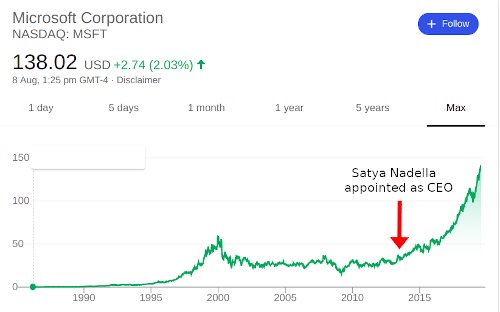You are not sure if outsourcing is right for your business.
You know outsourcing can help you save on costs. But you are worried about the communication gap, quality of work, and reliability.
Well, it turns out you can dramatically increase your chances of successfully outsourcing with a few simple hacks that I will share with you in this post.
In fact these principles have helped our clients to successfully outsource and improve profit by 163% in the past year.
In this post we are going to talk about:
The advantages of outsourcing and how to make it work for you
The disadvantages of outsourcing and how to avoid these pitfalls.
Advantages of Outsourcing
Let me start by telling you a story about a giant of the tech industry…bear with me for a minute.
Mid 2014: Shareholders very unhappy, CEO is asked to resign. To everyone’s surprise in comes a new CEO, a complete unknown.
Fast forward to 2019:
In a span of five years this man has taken a giant company that was lost, to once again become a market force in its industry. This man is none other than Microsoft CEO Satya Nadella.

Why do I bring this up? Well, it has to do with point no. 1, the most important advantage of outsourcing.
1) Lower cost not quality:

By outsourcing you will be able to lower costs without lowering quality. You may be paying 60k per year for a college graduate. You can get one in India for 15k per year.
India is home to some of the best educational institutes in the world. Satya Nadella, the Microsoft CEO studied in India (including his undergrad).
He was fortunate enough to migrate to the US, but these days, the US immigration system is broken and there are a lot of talented people who are unable to migrate.
Outsourcing is a great way to tap into this talent pool.
Here is how you can do it:
Looking to hire top engineers? These are top 10 tech schools:
- IIT Delhi
- IIT Bombay
- IIT Kharagpur
- IIT Kanpur
- Birla Institute of Technology & Science
- IIT Guwahati
- National Institute Of Technology
- IIIT Hyderabad
- NIT Karnataka
IITs are notorious hard to get into. Their acceptance rate is 1%. As a reference point – Harvard has an acceptance rate of 8%.
Top talent is expensive, if you are looking for a slightly cheaper option, you can consider some great Tier 2 schools.
Looking to hire business majors? These are top B-schools:
- IIM Bangalore
- IIM Ahmedabad
- ISB Hyderabad
- IIM Calcutta
- FMS Delhi
- XLRI Jamshedpur
- IIM Lucknow
- SPJIMR Mumbai
- IIM Kozhikhode
- IIFT Delhi
- IIM Indore
Looking to hire graphic designers? These are top design schools:
- NID
- NIFT
- IIT-B
- IIT-G
- Srishti
- Mit-id
- Symbiosis
- Strate
To summarize:
Hiring top talent in India will help you lower costs without sacrificing on the quality.
2) Access to larger talent pool

India is home to more than 15 million engineers and 30 million graduates. For every job posting we get 1000s of well-qualified applicants to choose from.
Herein lies a problem:
Do you really have the time to interview 1000’s of candidates?
Unless you’re Marvel’s Dr Strange, I am guessing not.
So, here is what you need to do:
Make sure you have filters, so that only the best make it to the interview round.
Try this:
Round 1: Test for English skills.
As a part of the first round email the candidates 4 to 5 general interview questions.
Here is an interview question that I use:
Q) What has been your greatest failure? How did you handle it? What did you learn from it?
And what makes a good answer? Well, we evaluate the responses on the criteria below
- Clarity of thought
- Grammar
- Sentence formation and structuring
- Spelling
This is what a good answer looks like:

This is a what a bad answer looks like:

Round 2: Test for logical skills
As a part of the second round email the candidates 4 to 5 logic-based interview questions.
Here is an interview question that I use:
- Price: “x”
- Tax: 18% on price
- Retail price: price + tax
If the retail price is $120 what is the price before tax?
This is a trick question; most candidates don’t get it right, they will answer: $98.4
But, the right answer is $101.69.
Pro tip: Using Zapier you can automate this round. Only candidates who provide the right answer will advance to the next round.
Round 3: The Assignment
Only candidates that successfully complete Rounds 1 and 2 make it to this round.
In this round, you should provide the candidates with an assignment that is similar to a task that he is likely to encounter if he is working for your company.
This is a great chance to evaluate the quality of work.
Round 4: Interview and CV
Rounds 1,2, and 3 narrow down the field drastically. Now you can schedule an interview with the remaining few candidates.
Have a look at their CV and hire an employee who is not only technically competent but who is also a fit culturally.
3) Technology

With great software such as Zoom, Slack, Microsoft Teams, Google Hangouts and Skype, as well as access to really fast Internet, technology has made it really easy to work and coordinate with your remote team.
It is almost as if your remote employee is sitting right next to you.
Here is what we recommend:
For video conference:
Zoom has all the features that you need in a video conferencing application: Chat, built-in collaboration tools, and screen sharing. Screen recording and meeting recording can be saved on the cloud.
Moreover, you can use Zoom on any device – mobile or desktop.
Zoom has a free plan that you can try. The paid plans start from $14.99 per host per month.
Pro-Tips: Zoom works great with the basic hardware i.e., laptop and phone. But if you really want to take it to the next level, I suggest you check their video conferencing hardware solutions.
Here is one we like: Logitech Tap
Software for Chat:
Google hangout works best for most companies. But if your requirement is more complicated e.g., your organization has multiple people working on multiple separate projects, then I would recommend Slack or Microsoft teams.
In Slack, you can create a “channel” for every project and add people to it. You can chat and share files. Think of it like email on steroids.
Software for Project Management:
We recommend Asana or Trello. Both are very easy to use and intuitive.
Trello is more board style.
Whereas Asana is checklist style
With these applications you can create projects, add milestones, add tasks and subtasks to complete, assign tasks and projects, and add deadlines: Basically a-z of project management.
Other softwares:
If you need or want time tracking and monitoring software, I recommend WorkSnaps. This software tracks remote employees’ computer usage. It also takes screenshots of the employee’s desktop every 10 minutes.
Text me, Text now, MagicJack, and Vonage are few of the companies that provide local US (or any other country) phone numbers that your remote employees can use.
4) You can focus on your core

You can start by outsourcing menial and mundane tasks. Need to call UPS to find out where your package is? You can easily outsource such tasks to a remote employee.
By doing this, your in-house employees will have more time to focus on their key business tasks.
A great place to start is to do a calendar audit. This is a great way to know whether you are spending your time wisely.
List all the mundane and routine tasks that need to be done but don’t add any value to the company.
For example: Calling UPS to schedule a pickup.
Now, ask the other employees in your company to do the same.
At the end of this exercise you will have a list of tasks that are necessary for your business to function, but which are not vital for its growth.
These are perfect tasks to outsource to a remote employee. Doing this will free up valuable time for you and your team to focus on your core work.
Disadvantages of Outsourcing
1) They are not in the same physical location

A remote employee may take some time to get used to. It’s always nicer to see the people who you work with sitting across the room, and to share a drink after work.
With a remote employee, more often than not the primary mode of communication is either a video call or GChat.
Yes, technology has come a long way, I say we are almost 90% of the way towards solving this problem. With facilities like video calling and screen sharing, it is almost as if the person is right next to you.
How to bond with your remote team:
Have a weekly bonding session lasting 30 mins, Friday evenings often work well.
Here are few things you can try:
1) Quizbreaker: This is a great ice breaker game.
Here is how it works:


2) Two Truths and a Lie
This is another great game for team bonding.
Each player enters three facts about themselves; two are true and the other one is a lie. The other players now need to figure out which statement is a lie.
Example:
- I have visited more cities in the United States than my home country – India.
- I once ate 12 donuts for breakfast.
- I can fly a plane.
Go on now…find the lie 🙂
Here is an online version that you can play with your remote employees.
3) Dedicated Slack channel
If you use Slack (which I highly recommend), you can create a channel called #weekend or use the #random channel. Encourage remote and local employees to post about their lives on these channels.
You can also check out the Slack add on app: Donut. This app will pair two random employees in your organization for a chat every few weeks. This is a great way for your remote employee to interact with employees from other teams.
4) Other activities: You can stream movies over video conference and your remote team can watch along with the in-house team. You can also conduct a photography competition; anyone with a smartphone can participate.
Pro tip: Send out a survey to get feedback after every office hangouts session.
2) Communication

One of the major concerns is the communication barrier. How good are their verbal skills? How good are their email-writing skills? Do things get lost in translation?
How to avoid this?
The key here is hiring. Only hire offshore employees who have excellent oral and written skills. You can have a verbal test as part of the interview process.
There are also some great training courses on Udemy. By getting your remote employees to undertake them you can bridge the communication gap that may exist.
Here are a few that we like:
- Learn How To Communicate Successfully With U.S. Americans
- American English | Phrases for Work
- Learn American English Online
Another great source is YouTube. You can create your own course by making a playlist of videos you like.
Here are a couple of videos you can add to your remote employee’s playlist:
- 45 Common Phrases In American English
- How To Speak English Like An American
- 23 American Words That You Need To Know
How much training is needed?
Usually, if you hire well, the answer is none at all or very little.
But if an employee needs some help, then we suggest 20 mins a day for a month.
Pro tip: Choose courses that are well reviewed, have some practical exercises included and where the instructor is available to help with queries; this way you shouldn’t need to spend any time on it yourself. Another option is to ask your service provider / hiring agency to do the training.
3) Problems With Quality (Sometimes)
We all love high-quality work, don’t we?
You may feel that by outsourcing you are going to lose control of the process. You may feel that the quality may drop. It needn’t be this way.
There is a very easy fix:
Before you start the process of outsourcing make sure you have a quality metric setup. The key here is not to compromise.
If a remote employee’s work is not up to the required quality, then replace him. Keep looking until you find the ideal candidate (A little patience might be required, but you will find him).
Setting the bar high right from the first remote employee is essential. He is the flag bearer for quality in your remote team; later hires will measure themselves up to the initial employees.
Performance reviews every six months and regular one-on-one meetings are a must.
By providing regular feedback through performance reviews and one-on-one meetings your remote employee will clearly understand the standard and quality of work expected from him.
You should never compromise on the quality of the deliverable.
4) Company Culture
It is harder to instill your company’s culture in a remote employee. Harder but not impossible. It can be done.
Just because they are not in the same location doesn’t mean that they are not a part of your company.
Culture is not just fancy words like these:
- Communication
- Respect
- Integrity
- Excellence
In an annual shareholders meeting Enron mentioned the above values as their culture. But was this really their culture? Did they really take these values seriously? It couldn’t have been.
Enron was charged with financial fraud. Their CEO is serving time and the company is bankrupt now.
Make sure you mean it
Netflix is a great example of this, the culture deck is a 125-slide ppt.
Netflix’s CEO Reed Hastings proudly says – Over the years Netflix either let go or didn’t hire people who were extraordinary talented because they didn’t fit Netflix’s culture.
Your company’s culture is the glue that sticks together and aligns all the employees of your company.
It is essential that your remote employees understand your company’s culture and values.
It is advisable to share the culture deck during the onboarding process—even better if you can include a culture workshop as a part of onboarding.
5) Longer training time:

Training sessions might be a little harder as you conduct them over video call/screen sharing rather a one-on-one session.
How to fix this:
It is important to understand that your remote employee is from a different part of the world with its own cultures, hence it may take them a little longer to understand your methods and practices.
It is essential that you allocate more time for training compared to local employees. The more time you spend upfront, the more the chance of things going wrong later decreases.
It is very important that the remote employee understands your methods and practices.. It is much easier to train a remote employee during the first few weeks and create new work habits according to your liking than trying to break bad ones two months down the line.
Final thoughts:
Outsourcing has many advantages. At the same time, you shouldn’t underestimate the cons, you will need a rock-solid plan that will help you minimize the risk in order to succeed. This is where we can help 🙂
Outsourcing is a high-leverage activity when done right.
Liked what you read? Now is the perfect time to take your business to the next level by setting up an offshore team in India. A quick 15 mins Zoom call & we’ll tell you all about it.


